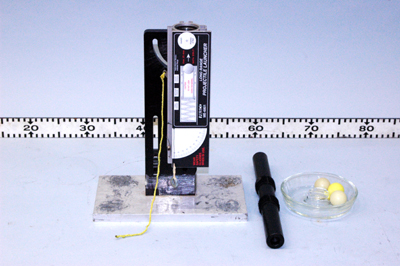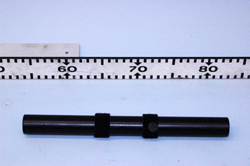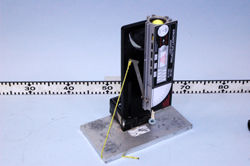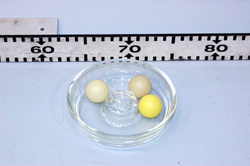|
Size: 1750
Comment:
|
← Revision 7 as of 2013-07-12 18:18:22 ⇥
Size: 2972
Comment: converted to 1.6 markup
|
| Deletions are marked like this. | Additions are marked like this. |
| Line 2: | Line 2: |
| ||<:30%>[:PiraScheme#Mechanics: Table of Mechanics Demonstration]||<:30%>[:MEEquipmentList: List of Mechanics Equipment & Supplies]||<:30%>[:Demonstrations:Lecture Demonstrations]|| | ||<:30%>[[PiraScheme#Mechanics| Table of Mechanics Demonstration]]||<:30%>[[MEEquipmentList| List of Mechanics Equipment & Supplies]]||<:30%>[[Demonstrations|Lecture Demonstrations]]|| |
| Line 7: | Line 7: |
| Motion in One Dimension, [:MotionIn1D#UniformAcceleration: 1F20. Uniform Acceleration] | Motion in One Dimension, [[MotionIn1D#UniformAcceleration| 1F20. Uniform Acceleration]] |
| Line 10: | Line 10: |
| * '''Cabinet:''' [:MechanicsCabinet:Mechanic (ME)] * '''Bay:''' [:MechanicsCabinetBayA5:(A5)] |
* '''Cabinet:''' [[MechanicsCabinet|Mechanic (ME)]] * '''Bay:''' [[MechanicsCabinetBayA5|(A5)]] |
| Line 14: | Line 14: |
| attachment: mainPhoto | {{attachment:PascoLaucher-02-400.jpg}} |
| Line 18: | Line 18: |
| Using Pasco projectile launcher - A projectile is launched vertically from a risen platform relative to the ground. The projectile will reach a maximum height, stop, then fall the the ground reaching its greatest speed just before impact. Insert succinct description of demonstration. |
Using the Pasco projectile launcher, a projectile is launched vertically from a risen platform relative to the ground. The projectile will reach a maximum height, stop, then fall to the ground reaching its greatest speed just before impact. |
| Line 23: | Line 23: |
| ||apparatus||ME, Bay B1, Shelf #2|| || ||all other parts||ME, Bay B1, Shelf #2|| || ||...||ME, Bay B1, Shelf #2|| || |
||Pasco Launcher||ME, Bay A1, Shelf #1||1D60.30 || ||Pasco Projectiles||ME, Bay A1, Shelf #1|| || ||Pasco Loading Rod||ME, Bay A1, Shelf #1|| || |
| Line 29: | Line 29: |
| * ''''' ''''' | * N/A |
| Line 34: | Line 34: |
| 1. List steps for setup then procedure. 1. ... |
1. Position the Pasco launcher on the table, and adjust the angle so that it is oriented vertically relative to the floor. 1. Load the launcher by placing a Pasco projectile in the launcher, and push it down with the loading rod until the |
| Line 38: | Line 38: |
| * | * DO NOT look down the barrel of the projectile launcher - a spontaneous launch could take your eye! * Take care to not aim the projectile launcher at or near the audience; also keep in mind the possible post-contact trajectories of the projectile. |
| Line 43: | Line 44: |
| Discuss the physics behind the demonstration, explaining some of the various steps of the demonstration when appropriate. | The only force on the projectile after it leaves the launcher is gravity. It is given an initial velocity by the launcher. The position of the projectile as a function of time is given by the position equation y(t)=(1/2)*g*t^2^+v,,0,,*t where y is the vertical displacement relative to the launcher muzzle, t is the time elapsed since launch, g is the acceleration due to gravity 9.81 m/s^2^ and v,,0,, is the initial velocity of the ball. A rough estimate of the muzzle velocity can be obtained by measuring the spring constant of the launching spring inside the launcher. Also, the mass of the projectile, the compressed length of the spring at each of the three strength settings, and the uncompressed length of the spring would need to be measured. Hooke's Law can then be applied to obtain the kinetic energy imparted to the projectile and therefore its initial velocity. |
| Line 45: | Line 46: |
| ||attachment: photo||attachment: photo||attachment: photo||attachment: photo|| | ||{{attachment:PascoLaucher-03-250.jpg}}||{{attachment:PascoLaucher-04-250.jpg}}||{{attachment:Project-02-250.jpg}}|| |
| Line 48: | Line 49: |
| * [https://www.youtube.com/user/LectureDemostrations/videos?view=1 Lecture Demonstration's Youtube Channel] | * [[https://www.youtube.com/user/LectureDemostrations/videos?view=1|Lecture Demonstration's Youtube Channel]] |
| Line 52: | Line 53: |
| * List any references | * N/A |
| Line 55: | Line 56: |
| [:Instructional:Home] | [[Instructional|Home]] |
Vertical Projectile Launcher, 1C20.60
Topic and Concept:
Motion in One Dimension, 1F20. Uniform Acceleration
Location:
Cabinet: Mechanic (ME)
Bay: (A5)
Shelf: #1

Abstract:
Using the Pasco projectile launcher, a projectile is launched vertically from a risen platform relative to the ground. The projectile will reach a maximum height, stop, then fall to the ground reaching its greatest speed just before impact.
Equipment |
Location |
ID Number |
|
|
|
Pasco Launcher |
ME, Bay A1, Shelf #1 |
1D60.30 |
Pasco Projectiles |
ME, Bay A1, Shelf #1 |
|
Pasco Loading Rod |
ME, Bay A1, Shelf #1 |
|
Important Setup Notes:
- N/A
Setup and Procedure:
- Position the Pasco launcher on the table, and adjust the angle so that it is oriented vertically relative to the floor.
- Load the launcher by placing a Pasco projectile in the launcher, and push it down with the loading rod until the
Cautions, Warnings, or Safety Concerns:
- DO NOT look down the barrel of the projectile launcher - a spontaneous launch could take your eye!
- Take care to not aim the projectile launcher at or near the audience; also keep in mind the possible post-contact trajectories of the projectile.
Discussion:
The only force on the projectile after it leaves the launcher is gravity. It is given an initial velocity by the launcher. The position of the projectile as a function of time is given by the position equation y(t)=(1/2)*g*t2+v0*t where y is the vertical displacement relative to the launcher muzzle, t is the time elapsed since launch, g is the acceleration due to gravity 9.81 m/s2 and v0 is the initial velocity of the ball. A rough estimate of the muzzle velocity can be obtained by measuring the spring constant of the launching spring inside the launcher. Also, the mass of the projectile, the compressed length of the spring at each of the three strength settings, and the uncompressed length of the spring would need to be measured. Hooke's Law can then be applied to obtain the kinetic energy imparted to the projectile and therefore its initial velocity.
|
|
|
Videos:
References:
- N/A


